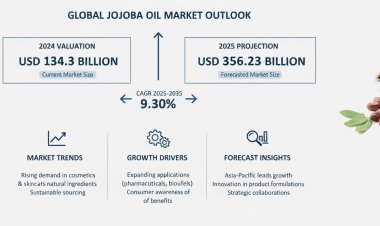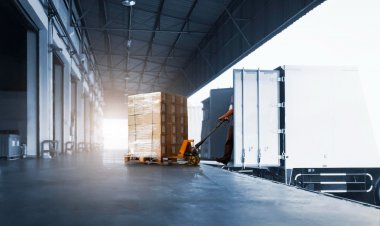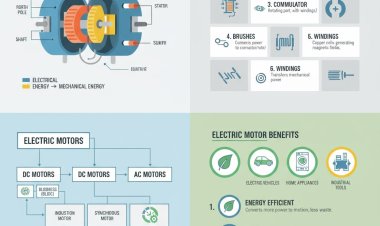Cold Chain Logistics Market Growth Projections for 2030
Explore the rapid growth of the Cold Chain Logistics Market, key drivers, future trends, and regional insights. Learn about technological advancements, e-commerce influence, and strategic opportunities.

Global Cold Chain Logistics Market Trends & Projections | 2023–2030
The Cold Chain Logistics market is witnessing unprecedented growth globally, driven by increased demand for temperature-sensitive products such as pharmaceuticals, fresh produce, frozen goods, and dairy products. According to Vantage Market Research, the Global Cold Chain Logistics Market was valued at USD 238.47 million in 2022 and is expected to reach USD 685.02 million by 2030, growing at a Compound Annual Growth Rate (CAGR) of 14.10% during the forecast period. This growth trajectory is underpinned by several key drivers including the globalization of food trade, stricter regulations for food safety, and surging consumption of perishable goods, particularly in urban settings.
Importantly, regulatory compliance related to food and pharmaceutical safety across regions such as the U.S., European Union, and increasingly in Asia, has compelled manufacturers and distributors to invest heavily in cold chain systems. Moreover, escalating demand for biopharmaceutical products such as vaccines, which require tightly controlled storage temperatures, has contributed to heightened dependency on sophisticated cold chain infrastructures.
Among the key regional contributors to market share, North America continues to dominate the global cold chain logistics space due to its advanced infrastructure, robust regulatory framework, and high levels of investment in automation and digital monitoring solutions. However, the Asia-Pacific region is experiencing the fastest growth, largely driven by increased disposable incomes, rapid urbanization, and the expanding e-commerce ecosystem. China and India, in particular, are emerging as pivotal markets due to a growing middle class and initiatives to reduce food wastage through better logistics.
Several multinational companies are also capitalizing on this opportunity by expanding their cold chain networks and forming strategic alliances with local logistics players. Companies like Americold Logistics, Lineage Logistics, and DHL Supply Chain are aggressively leveraging technology and innovation to strengthen their capabilities and gain a competitive edge.
Technological Advancements in Cold Chain Logistics
Cold chain logistics has undergone a technological renaissance in recent years, with the integration of advanced systems like the Internet of Things (IoT), Radio-Frequency Identification (RFID), and artificial intelligence (AI). These technologies play a vital role in enhancing transparency, accountability, and efficiency across the cold chain network. One of the most significant innovations is the deployment of IoT-enabled devices that allow real-time tracking of temperature, humidity, and location. These devices help stakeholders react promptly to any aberrations, thereby minimizing product loss and maintaining regulatory compliance.
RFID technology is similarly transformative, enabling quick identification and automated tracking of goods throughout the supply chain. Unlike traditional barcode systems, RFID tags can store a wide range of data and be read without direct line-of-sight, improving inventory management and reducing human errors. When combined with cloud-based platforms and AI analytics, RFID systems can deliver insights that streamline operations and optimize route planning, warehouse management, and distribution strategies.
Automation is also making strong inroads into cold storage management. Advanced robotics are increasingly used in refrigerated warehouses for picking, sorting, and packing operations, minimizing human labor in sub-zero environments while significantly boosting efficiency and accuracy. Automated Storage and Retrieval Systems (ASRS) can further enhance space utilization and reduce energy consumption by precisely controlling internal temperatures and minimizing door openings.
Temperature-monitoring software platforms, often paired with GPS, now allow companies to maintain centrally coordinated systems that can flag deviations and initiate corrective actions remotely. This level of control is crucial, especially in pharmaceutical logistics, where compliance with Good Distribution Practices (GDP) and other stringent regulations demand high levels of traceability and documentation.
The integration of blockchain technology is another frontier, providing immutable records of product movements and status along the supply chain. This innovation not only improves traceability but also builds consumer trust by ensuring authenticity and transparency.
Impact of E-commerce on Cold Chain Demand
The rise of e-commerce, particularly in the food and grocery sectors, has significantly altered the demand landscape for cold chain logistics. A decade ago, consumers were hesitant to order perishable goods online due to concerns surrounding product freshness and delivery dependability. Today, growth in online grocery sales—especially after the acceleration brought on by the COVID-19 pandemic—has necessitated major overhauls in refrigerated logistics infrastructure.
E-commerce platforms have introduced new levels of complexity in the cold chain network, requiring timely and small-volume deliveries directly to consumers. Unlike traditional B2B cold logistics that deal in bulk shipments, e-commerce-driven models must navigate short delivery timeframes, distributed warehousing, and last-mile challenges—all while maintaining optimal temperature conditions.
Additionally, changing consumer preferences, including a move toward organic, high-protein, and ready-to-eat meals, have expanded the range of perishable goods demanding specialized transport solutions. In response, retailers and logistics providers are increasingly investing in multi-temperature delivery vehicles, smart tracking software, and micro-fulfillment centers close to consumer hubs.
Packaging innovation has also played a significant role in accommodating the demands of e-commerce cold chain logistics. Sustainable, thermally insulated packaging options like phase change materials (PCMs), vacuum-insulated panels (VIPs), and gel-based coolants are now widely used to maintain product integrity. These materials are not only more efficient in managing thermal conditions but are also lighter and often biodegradable, addressing environmental concerns.
Subscription-based meal kits and grocery delivery services have also taken root, demanding consistent cold chain reliability to maintain customer satisfaction. Companies like HelloFresh, Blue Apron, and Instacart rely heavily on advanced cold chain logistics to deliver fresh ingredients without spoilage.
The intersection of e-commerce with cold chain logistics is creating both immense opportunities and operational complexities, necessitating continual innovation in both service capabilities and infrastructure expansion.
Challenges Facing Cold Chain Logistics
While the global cold chain logistics sector is poised for robust growth, it is not without formidable challenges. One of the primary issues facing the industry is the high energy consumption associated with refrigerated transport and storage. Cold chain operations rely heavily on refrigeration systems that consume significant electricity and diesel, leading to high operational costs and sizable carbon footprints.
This energy dependency poses a dual threat: profitability and sustainability. There is increasing pressure on logistics providers to transition toward eco-friendly practices, carbon neutrality goals, and the adoption of alternative energy sources. Yet the cost of investing in green infrastructure—solar-powered cold storage, fuel-efficient refrigeration units, or biothermal packaging—remains a significant barrier, especially for small- and medium-sized enterprises.
Regulatory compliance across international borders is another complex hurdle. Products like pharmaceuticals, which fall under the scrutiny of agencies such as the FDA in the U.S. and EMA in Europe, face stringent transportation and documentation requirements. Failure to maintain specified conditions can result in product spoilage, financial loss, and even legal ramifications. Navigating this web of global compliance requires deep expertise and robust technological systems.
Infrastructural shortcomings, particularly in developing economies, also plague the cold chain ecosystem. Many countries lack sufficient temperature-controlled storage facilities or refrigerated transport fleets, leading to high spoilage rates. The absence of reliable electricity, skilled labor for handling perishable goods, and logistical coordination further compounds these problems.
High capital investment is another deterrent. Establishing cold storage units, refrigerated trucking fleets, and integrated tech systems requires significant upfront expenditure. Investors and logistics companies must consider long payback periods, even as technological obsolescence looms due to rapid advancements in automation and analytics.
These challenges make collaboration across public and private sectors vital. Governments, international food organizations, and logistics companies must work together to build sustainable solutions that ensure cold chain integrity while also supporting long-term growth in underserved regions.
Regional Growth Trends in Cold Chain Markets
The global cold chain logistics market is influenced heavily by regional trends, which vary significantly based on economic development, infrastructure capabilities, population demographics, and consumer habits. North America currently holds the largest share of the market, benefiting from strong infrastructure, regulatory enforcement, and the early adoption of advanced logistical technologies. The United States, in particular, features an extensive network of temperature-controlled warehouses, advanced monitoring systems, and a mature e-commerce sector—all of which facilitate the efficient movement of perishable goods.
Canada also contributes significantly to the region's cold chain strength, particularly in sectors such as pharmaceuticals, frozen and fresh produce, and seafood. Moreover, stringent regulations enacted by the U.S. Food and Drug Administration (FDA) and other bodies continue to push for robust cold chain standards. North American logistics providers are responding with increased investment in automated warehouses, cross-docking terminals, and GPS-IoT integrated solutions that provide real-time oversight of the cold chain journey.
In contrast, the Asia-Pacific region is experiencing the most rapid growth and is projected to be the fastest-growing region over the forecast period. With rising urbanization, growing middle-class income, and increasing awareness of food safety standards, countries like China, India, Japan, and South Korea are seeing dramatic shifts in cold chain infrastructure development. China, for example, is heavily investing in cold chain technology as it grapples with one of the largest food supply chains globally. The Chinese government has launched multiple initiatives to reduce food waste and improve cold chain systems at both national and provincial levels.
India, too, shows immense potential. Post-COVID, the online grocery and pharmaceutical sectors have surged, prompting renewed emphasis on cold storage development. Despite historical shortcomings in infrastructure, innovations in decentralized cold storage, public-private partnerships, and foreign direct investment are beginning to transform the Indian cold chain ecosystem.
Europe, with its strong consumer demand for organic produce and meat products, also remains a prominent market. Countries such as Germany, France, and the UK boast highly-regulated and technologically advanced systems that are driving demand for regional cold chain partnerships. Environmental regulations play a significant role here, pushing for energy-efficient cold chain solutions and low-emission refrigerated transport.
In South America, Brazil and Argentina are emerging players, especially in the meat and seafood export business, requiring reliable cold storage and temperature-controlled transport systems. Similarly, regions in Africa and the Middle East are gradually adopting cold chain solutions, especially in areas where food security concerns and pharmaceutical needs are escalating. International organizations such as the FAO and WHO have supported cold chain development in these regions to strengthen their healthcare and food distribution systems.
Market Segmentation Insights
The cold chain logistics market is intricately divided based on application, end-users, transportation modes, and storage types. Among the most prominent application segments are food & beverages, pharmaceuticals, chemicals, and agriculture. The food industry dominates due to the perishable nature of products like dairy, seafood, ready-to-eat meals, and gourmet frozen foods, all requiring precise temperature management across transit and storage phases.
With consumer demand shifting toward health-conscious, fresh, and organic food options, the refrigerated transport segment of the market must pivot accordingly. A notable sub-segment in this vertical is frozen foods, projected to witness accelerated growth due to the popularity of convenience meals and increasing dual-income households that opt for ready-to-cook products.
The pharmaceutical segment is witnessing exponential growth, particularly for biologics, vaccines, blood samples, and temperature-sensitive drugs. With the global expansion of the biotechnology industry and high-value biological products requiring storage at ultra-low temperatures (often -80°C or lower), a specialized cold chain infrastructure with cutting-edge technology is essential. The recent demand for mRNA COVID-19 vaccines exponentially increased investments in pharmaceutical cold chains, highlighting vulnerabilities and spurring upgrades in global systems.
From a transportation perspective, the market is fragmented into refrigerated road transport, air freight, ocean shipping, and rail logistics. Road transportation holds the largest share due to its versatility and last-mile delivery capabilities. However, airfreight is witnessing significant interest in pharmaceutical and urgent fresh produce logistics due to delivery speed. Rail and maritime solutions are more common in bulk transportation, though they come with challenges in maintaining consistent temperature over longer durations.
In terms of storage, refrigerated warehouses and distribution centers form essential nodes of the cold chain. Innovations like automated storage and retrieval systems (ASRS), hyper-localized micro-fulfillment centers, and modular cold room solutions are trending to address issues around energy use and space constraint. Refrigerated warehouse capacity is predicted to witness extensive growth, especially near urban centers where consumer demand for fresh foods and fast delivery is highest.
Future Growth Projections and Trends
Looking forward, the cold chain logistics market is expected to play an increasingly crucial role in global trade, public health systems, and food security. As per projections from Vantage Market Research, the market will reach USD 685.02 million by 2030, up from USD 238.47 million in 2022, growing at a robust 14.10% CAGR. This growth will be led by factors such as increased demand for temperature-sensitive products, cross-border trade of perishables, and expansion of the pharmaceutical industry.
One of the defining trends expected in the coming years is the integration of AI, machine learning, and advanced data analytics for cold chain optimization. Predictive analytics will allow logistics companies to model supply and demand more efficiently, allocate resources dynamically, and preemptively avoid disruptions caused by weather, traffic, or equipment failure.
Sustainability and green logistics will play a significant role in shaping the future of the industry. As governments and consumers alike push for reduced carbon emissions, innovations such as electric refrigerated trucks, solar-powered cold rooms, and biodegradable insulated packaging will become standard.
Strategic collaborations and mergers will also define market evolution. Large logistics firms are likely to acquire smaller, tech-savvy cold chain startups that possess niche expertise or regional networks. Investments from private equity and venture capital sources into cold supply chain infrastructure, particularly in emerging economies, are also expected to surge.
Additionally, urban cold chain logistics will become more prevalent as companies seek to meet the increasing demand for same-day and express grocery deliveries in metropolitan areas. This will require hyperlocal cold storage, mini-distribution hubs, drone-based deliveries, and advanced route planning technologies to minimize delays and emissions.
The demand for global traceability is also expected to rise. With rising food fraud and counterfeit drug issues, stakeholders will turn to blockchain and end-to-end traceability solutions to ensure trust, transparency, and regulatory compliance.
FAQs
- What are the key drivers of growth in the Global Cold Chain Logistics Market?
- How is the Cold Chain Logistics Market projected to evolve by 2030?
- What factors contribute to the Compound Annual Growth Rate (CAGR) of 14.10% in this market?
- In which regions is the Global Cold Chain Logistics Market expected to see significant growth?
Concluding Remarks on Market Dynamics
The cold chain logistics market has emerged as a critical component of the modern global supply chain, enabling access to fresh food, life-saving medicines, and temperature-sensitive chemicals across vast geographies. The market’s growth—from USD 238.47 million in 2022 to a projected USD 685.02 million by 2030—reflects increasing reliance on cold chain solutions for both B2B and B2C segments.
The competitive landscape is marked by the presence of multinational giants like Lineage Logistics, Americold, DHL Supply Chain, FedEx, and Maersk, along with regional players entering the fray to cater to local and niche demands. These players are increasingly investing in digital transformation, vertical integration, and global expansion to gain market share and improve service resilience.
Despite significant growth forecasts, the market faces notable challenges, including climate concerns, aging infrastructure in certain regions, and regulatory inconsistencies. Yet these very obstacles have also inspired a wave of innovation—ranging from IoT-enabled temperature monitoring to energy-efficient refrigeration and AI-driven supply chain management.
As e-commerce matures, consumer behaviors evolve, and pharmaceutical innovations continue, cold chain logistics will remain indispensable. Market participants with the foresight to invest in sustainability, personalization, and digital capabilities will be best positioned to capture future opportunities and establish long-term resilience.
In summary, cold chain logistics is no longer just a support function—it is a strategic asset for food security, healthcare continuity, and global commerce. Companies that align with emerging trends and invest in adaptive, tech-enabled infrastructures will reap substantial rewards in the decades ahead.
☎ Contact Us:
224 W 35th St Ste 500 New York,
USA/Canada Toll Free +1(877) 462-2282
+1(212) 951-1369
✉ Email: [email protected]
???? Website: https://www.vantagemarketresearch.com


















